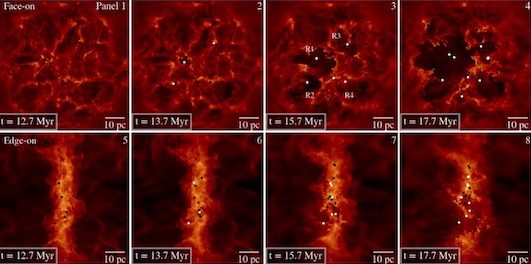We present radiation-magnetohydrodynamic simulations aimed at studying evolutionary properties of HII regions in turbulent, magnetised, and collapsing molecular clouds formed by converging flows in the warm neutral medium. We focus on the structure, dynamics and expansion laws of these regions. Once a massive star forms in our highly structured clouds, its ionising radiation eventually stops the accretion (through filaments) toward the massive star-forming regions. The new over-pressured HII regions push away the dense gas, thus disrupting the more massive collapse centres. Also, because of the complex density structure in the cloud, the HII regions expand in a hybrid manner: they virtually do not expand toward the densest regions (cores), while they expand according to the classical analytical result towards the rest of the cloud, and in an accelerated way, as a blister region, towards the diffuse medium. Thus, the ionised regions grow anisotropically, and the ionising stars generally appear off-centre of the regions. Finally, we find that the hypotheses assumed in standard HII-region expansion models (fully embedded region, blister-type, or expansion in a density gradient) apply simultaneously in different parts of our simulated HII regions, producing a net expansion law (\(R \propto t^\alpha\), with $\alpha$ in the range of 0.93-1.47 and a mean value of \(1.2 \pm 0.17\)) that differs from any of those of the standard models. (As it appears in the paper).
Zamora-Avilés, Manuel; Vázquez-Semadeni, Enrique; González, Ricardo F.; Franco, José; Shore, Steven N.; Hartmann, Lee W.; Ballesteros-Paredes, Javier; Banerjee, Robi; Körtgen, Bastian
2019, arXiv e-prints, 1903, arXiv:1903.01644
http://adsabs.harvard.edu/abs/2019arXiv190301644Z

